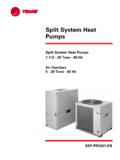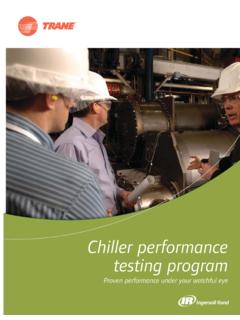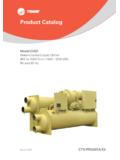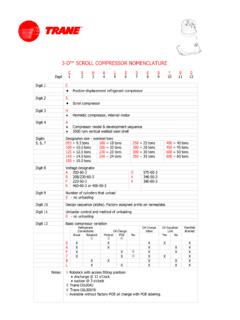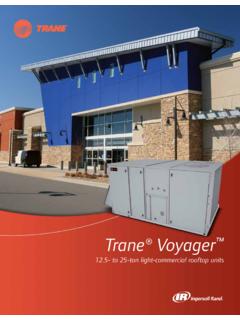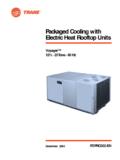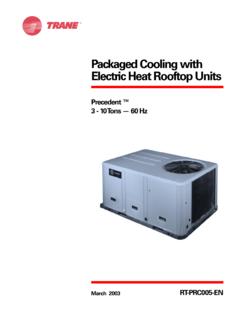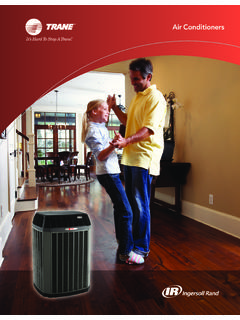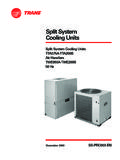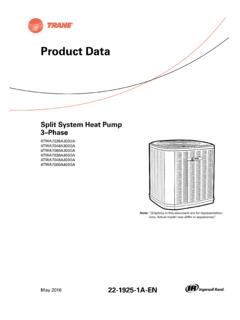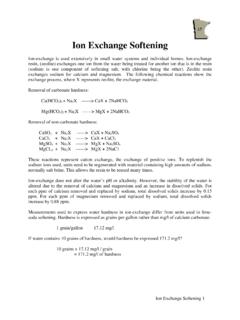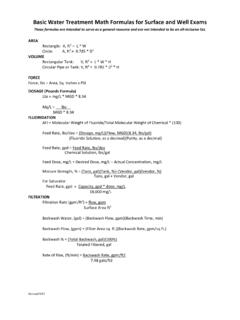Transcription of Energy-Saving Strategies for Water-Source Heat-Pump Systems
1 Engineers newsletter volume 36 2 providing insights for today's hvac system designer Energy-Saving Strategies for Water-Source Heat Pump Systems Heat rejected by the units operating in these applications, the benefit of this from the cooling mode is used to offset the heat heat recovery further reduces boiler Water-Source heat pump (WSHP) absorbed by the units in heating mode. energy use during the winter months. Systems are often known In this manner, a WSHP system (unfortunately) as a "low cost" provides a form of heat recovery and alternative. However, they have the an opportunity to save energy by potential to be high-performance reducing the need to operate the boiler Systems , reducing operating costs for Equipment/System or cooling tower.
2 For example, if the the building owner and improving water temperature stays in the desired Configuration Strategies occupant comfort. This EN contains a range between 60 F (16 C) and 90 F. "menu" of cost-effective, system design (32 C) neither the boiler nor the "Hybrid" Systems . The WSHP system and control Strategies that can be used cooling tower need to operate. is often viewed solely as an alternative to save energy in WSHP Systems . In to other types of HVAC Systems . general, each section can be read In applications such as office buildings, "Hybrid" Systems composed of water- independently, allowing the reader to heat generated by lights, people, and source heat pumps and other types of decide which Strategies make sense for office equipment often results in the HVAC equipment, however, may be a given application.
3 Need to provide year-round cooling in best suited to meet the specific the interior zones of the building. In requirements of a given building. Figure 1. Typical Water-Source heat pump system WSHP Systems are used to provide comfort in a wide range of building types and climates. In this type of system, each zone has a WSHP unit that is controlled to maintain the cooling tower desired temperature in that zone. All the heat pumps are connected to a common water loop (Figure 1). Also pumps connected to this water loop are a "heat rejecter" ( , cooling tower or geothermal heat exchanger), a "heat adder" ( , boiler or geothermal heat exchanger), circulation pumps , and boiler related accessories.
4 Typically, outdoor air is conditioned and delivered by a separate, dedicated ventilation system. horizontal During mild weather, such as spring or WSHPs fall, the heat pumps serving the sunny side and interior of the building often operate in cooling mode and reject rooftop heat into the water loop. The heat WSHPs pumps serving the shady side of the building often operate in heating mode and absorb heat from the water loop. vertical-stack vertical WSHPs WSHPs 2007 American Standard All rights reserved 1. Figure 2. "Hybrid" WSHP system Ground-source heat pump Systems . A well-known variation of the WSHP system uses the earth as the heat rejecter and heat adder cooling tower (Figure 3).
5 Ground-source Heat-Pump (GSHP) Systems * do not actually get pumps rid of heat, they store it in the ground for use at a different time. During the summer, the heat pumps extract heat from the building and transfer it to the ground. When the building requires boiler heating, this stored heat can be recaptured from the ground. In a perfectly balanced system, the amount horizontal WSHPs of heat stored over a given period of time would equal the amount of heat self-contained VAV air conditioner retrieved. Ground-source heat pump Systems to interior zones offer the potential for saving energy because they can reduce (or eliminate). the energy needed to operate a cooling vertical-stack vertical tower and/or boiler.
6 Eliminating the WSHPs WSHPs cooling tower has architectural and maintenance advantages, and While there are many possible These packaged units contain a eliminating the boiler frees up floor combinations, the example hybrid complete refrigeration circuit with a space in the building. system shown in Figure 2 uses water-cooled condenser that is variable-air-volume (VAV) self-contained connected to the common water loop. While eliminating both the cooling units to serve the interior zones of an The VAV supply fan varies the airflow tower and boiler likely results in the office building and Water-Source heat supplied to the interior zones, resulting greatest overall energy savings, for pumps to serve the perimeter zones.
7 In significant part-load fan energy most applications it requires the The interior zones in this type of savings, while the condenser heat is largest (and more expensive). building may have variable loads, but rejected to the loop so that it can be geothermal heat exchanger to account often require cooling year-round. absorbed by the heat pumps that are for the imbalance between heat stored providing heat to the perimeter zones. and heat extracted. Figure 3. Ground-source heat pump system For example, in a cooling-dominated climate, a large amount of heat must be rejected to the ground during the geothermal cooling season, but a much smaller heat exchanger pumps amount of heat is extracted from the ground during the heating season.
8 This imbalance can cause the temperature WSHPs of the ground surrounding the geothermal heat exchanger to increase over time. * A 2001 Engineers Newsletter (volume 30-2, "The Three E's of Geothermal Heat Pump Systems ") provides more detail on ground- source heat pump Systems . 2 trane Engineers Newsletter volume 36 2 providing insights for today's HVAC system designer Conversely, in a heating-dominated Figure 4. "Hybrid" GSHP system climate, a relatively small amount of heat is rejected to the ground during the cooling season, but a much larger cooling tower (or dry cooler). amount of heat must be extracted back out of the ground during the heating season. In this case, the temperature of the ground can decrease over time.
9 In either case, future operation of the heat pumps is compromised by this geothermal heat exchanger pumps change in ground temperature. In many areas of the country, this imbalance requires the geothermal WSHPs heat exchanger to be larger to prevent the ground temperature from changing over time. The first cost to install such a large heat exchanger often dissuades people from considering this approach. Using a "hybrid" approach, however, can often make GSHP Systems more economical, opening up the possibility to reap the potential energy savings. This "hybrid" approach involves adding a small cooling tower or dry cooler to the loop for a system that is installed in a bypass valve cooling-dominated climate (Figure 4), or adding a small boiler to a system in a Variable-flow pumping.
10 The water- amount of water required by the heating-dominated climate. In either circulating pumps can be either operating heat pumps . case, the geothermal heat exchanger is constant- or variable-flow pumps . sized based on the smaller of the two Constant-flow pumps operate In a variable-flow system, consider loads: for the total heat absorbed in a whenever the system is on, delivering installing an automatic balancing cooling-dominated climate or the total a constant flow of water throughout valve for each heat pump. This heat rejected in a heating-dominated the loop, and consuming a constant device helps ensure proper water climate. Then, a small cooling tower (or amount of energy.)
